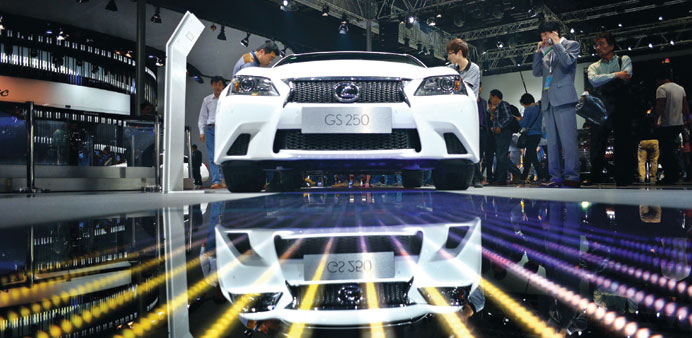Visitors look at a Lexus GS250 during the 16th Shanghai International Automobile Industry Exhibition. The glittering new products and concepts being unveiled at the expo by major automakers confirm China’s status as the most important car market in the world.
Bloomberg
Shanghai
The task of every major car show is to reflect the state of the auto industry, but few live up to the challenge as well as Shanghai’s auto show. Like the Chinese market itself, the show is big, chaotic and perplexing, and attendance is de rigueur for anyone who’s anyone in the global car business.
The glittering new products and concepts being unveiled at Auto Shanghai 2015 by the global major automakers confirm China’s status as the most important car market in the world. But they also provide a poignant counterpoint to the more modest offerings on display from China’s homegrown producers. For all the uncertainty that global automakers see in the cooling Chinese market, the Shanghai show proves that they – not China’s government-assisted automakers – are winning the war for the hearts, minds and pocketbooks of China’s growing consumer class.
Despite this year’s notable lack of scantily clad “booth babes” and an increase in sober expectations for Chinese market growth, the Shanghai auto show is still growing exuberantly. Two years ago, the event attracted more than 800,000 visitors; this year, it could be 1mn. But behind the Albert Speer-meets-Pelican Bay facade of the show’s massive new venue lurks yet another sign of the complicated mix of opportunity and risk facing the Chinese industry: Despite featuring more than 2,000 exhibitors this year, empty space abounded. Both the industry and its flagship event are built on a rampant belief in growth, yet they remain in constant risk of overcapacity.
Whether that overcapacity becomes an issue for the world’s automakers depends on how rapidly China’s once-white-hot growth slows. And while there are fears that a cooling market could bring a sharp correction, the auto industry seems to believe that the slowdown will continue to be gradual: “I don’t think 6-7% growth is bad news,” Nissan-Renault chief executive officer Carlos Ghosn said. Indeed, 7% annual growth would bring car sales in China to 35mn a year by the end of the decade, double the current US market.
But if the major global automakers seem content with the state of the Chinese market, the Chinese themselves are less enthused. After spending decades forging joint-venture partnerships with foreign brands, automakers are failing spectacularly at making progress in their home market: In 2014, nearly 8 out of 10 sedans sold in China were foreign-made. And at the Shanghai auto show, foreign-branded cars often are shown twice – once at the automaker’s lavish booth, then again at its Chinese joint venture partners.
The failure to win market share is not merely embarrassing to China’s auto policy goals, but it also puts domestic automakers on the front lines of overcapacity risk. China’s automakers have failed to compete with their established foreign competitors in part because of the government’s strategy of leveraging market access for technology transfers: With Chinese automakers receiving new auto technologies from Wolfsburg and Detroit, they have failed to build up their own technical capabilities at home. Chinese automakers have tended to simply mimic foreign technologies and designs, leading to copycat vehicles such as Jiangling’s Range Rover Evoque look-alike Landwind X7, just shown at the Guangzhou Auto Show. Until they begin developing their own independent R&D capabilities, their ability to compete with the foreign majors will remain stunted. And there was little evidence at the Shanghai show that this is happening.
The problem isn’t limited to the automakers: Consumers’ consistent preference for foreign-branded cars remains a major obstacle to China’s automotive ambitions. It’s not simply a question of foreign automakers building better cars; their brands are simply more popular with China’s growing middle and upper classes. In certain respects, this state of affairs resembles the frustrations faced by American automakers that have been pummelled in their home market as consumer preference shifts toward Japanese, German and Korean cars. And as years of government policies and bailouts have proven in the US, shifting consumer preferences to align with government priorities is never an easy task.
For now, Chinese automakers remain marginal players, stuck in the lower end of their domestic market while foreign competitors dominate the more profitable high end. Though the latest offerings have shown clear improvements, it’s clear that they will continue to struggle to make headway in an increasingly crowded Chinese market, let alone live up to the dreams of exporting cars around the world.
And the Chinese government is encouraging the production of greener “new energy vehicles” and hoping automakers use the opportunity to develop new technologies that push them to the forefront of the industry. But unless its automakers begin making their own advances, and until its consumers start buying Chinese cars for reasons other than lower cost, China’s car industry will remain a long way from matching the promise of its market.



